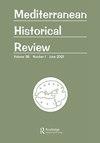Port cities of the eastern Mediterranean: urban culture in the late Ottoman Empire
IF 0.2
2区 历史学
Q1 HISTORY
引用次数: 2
Abstract
and rhetoric). A short concluding section reviews the causes of the downturn in Ibn Tulun’s fortunes prior to his death and the legacy of the state inherited by his son and successor, Khumarawayh. This biography provides a much-needed replacement for Zaky Hassan’s outdated study, Les Tulunides (1933). An exceptionally well-written, tightly constructed, and immersive study of a leading Abbasid personality, Gordon’s work makes the reader think about the social and political environment in which he acted and the nature of the surviving evidence of his life. It addresses the knotty problem of the source material for Ibn Tulun’s life, noting the lack of archival materials as well as physical evidence (the one exception being Ibn Tulun’s mosque), as well as the difficulties of using the two important biographies of Ibn al-Daya and al-Balawi. Constructed mainly from anecdotal testimony, these biographies present a mostly favorable view of their subject, praising him for his moral commitment and piety, as well as his determination and energy. But too little is known about their authors to judge how far their largely positive endorsement reflects the realities of his rule. As for the wider historical context, Ibn Tulun’s biography prompts us to wonder how was it that the Turkish ghilman corps, to which Ibn Tulun’s father belonged, had come to dominate the caliphal court by the time that Ibn Tulun set out for Egypt. What happened to the eastern Iranian noblemen and their Transoxanian soldiers that al-Muʿtasim had billeted alongside the Turkish military slaves in the barracks of Samarra less than three decades earlier? Second, where (and who) were the Egyptian elite in this story of the emergence of Egypt’s first independent Islamic governorate? The first opponents whom Ibn Tulun faced on his arrival were mostly expatriate members of the Abbasid elite, with strong connections to the caliphal court. The absence of local power brokers and militias at the center of power in Greater Fustat is striking, and provides a marked contrast to the politics of emergent regional polities elsewhere. The notion of a Tulunid “dynasty,” itself a product of the taxonomic imperatives of earlier scholarship, is rightly called into question by Gordon’s exposure of the fragility of ties that held the Tulunid household together after its founder’s death. Although the restricted format of the series in which the book appears precludes extensive contextualization, some reference to the wider issue of the emergence of contemporary “successor” states (Aghlabids, Saffarids, and Samanids) would have been helpful, in highlighting both the uniqueness of Ibn Tulun’s situation (in that he remained throughout his governorship a fully engaged member of the Samarran Turkish elite) and the diverse origins of contemporary regional governors. That apart, Gordon’s careful and judicious reconstruction of the career of Ibn Tulun provides a model for the kind of fine-grained biography that needs to be replicated for other rulers of emergent regional polities, before the causes and consequences of the decline of Abbasid authority and power in the later 9th century CE can be properly assessed.东地中海港口城市:奥斯曼帝国晚期的城市文化
和修辞)。一个简短的结语部分回顾了伊本·图伦去世前财富下滑的原因,以及他的儿子和继任者胡玛拉维继承的国家遗产。这本传记为扎基·哈桑过时的研究《图卢尼德》(1933)提供了急需的替代品。戈登的作品写得特别好,结构紧凑,对阿巴斯王朝的主要人物进行了身临其境的研究,使读者思考他所处的社会和政治环境,以及他生活中幸存的证据的性质。它解决了伊本·图伦生平资料来源的棘手问题,指出了档案资料和实物证据的缺乏(唯一的例外是伊本·图伦的清真寺),以及使用伊本·达亚和巴拉维的两本重要传记的困难。这些传记主要由轶事证词构成,对主人公的评价大多是正面的,赞扬了他的道德承诺和虔诚,以及他的决心和精力。但我们对这些书的作者知之甚少,无法判断这些大体上是正面的认可在多大程度上反映了他统治的现实。至于更广泛的历史背景,伊本·图伦的传记让我们想知道,在伊本·图伦出发去埃及的时候,伊本·图伦父亲所属的土耳其吉尔曼军团是如何统治哈里发宫廷的。不到30年前,al-Mu - tasim在萨迈拉的兵营里与土耳其军奴同住的东伊朗贵族和他们的Transoxanian士兵发生了什么事?其次,在埃及第一个独立的伊斯兰省出现的故事中,埃及精英在哪里(以及谁)?伊本·图伦抵达后遇到的第一批对手大多是流亡海外的阿巴斯王朝精英,他们与哈里发宫廷有着密切的联系。大福斯塔地区的权力中心没有地方权力经纪人和民兵,这一点令人震惊,这与其他地区新兴的地区政治形成了鲜明对比。图尼德“王朝”的概念本身就是早期学术分类学要求的产物,戈登揭露了在其创始人去世后将图尼德家族维系在一起的纽带的脆弱性,这一概念受到了正确的质疑。尽管书中出现的系列的有限格式排除了广泛的背景化,但一些关于当代“继承者”国家(Aghlabids, Saffarids和Samanids)出现的更广泛问题的参考将会有所帮助,以突出伊本·图伦处境的独特性(因为他在他的统治期间仍然是Samarran土耳其精英的充分参与成员)和当代地区统治者的多样化起源。除此之外,戈登对伊本·图伦的职业生涯的细致而明智的重建为其他新兴地区政治的统治者提供了一种精细的传记模型,这种传记需要在公元9世纪后期阿巴斯王朝权威和权力衰落的原因和后果得到适当评估之前得到复制。
本文章由计算机程序翻译,如有差异,请以英文原文为准。
求助全文
约1分钟内获得全文
求助全文

 求助内容:
求助内容: 应助结果提醒方式:
应助结果提醒方式:


